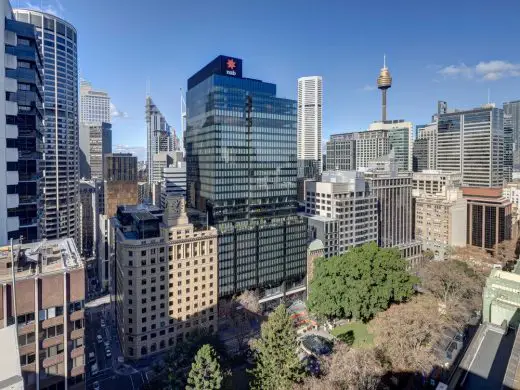Sub Base Platypus Renewal, Sydney Waterfront Promenade and Park, NSW Architecture, Australia Structural Design Images
Sub Base Platypus Renewal in Sydney
15 Nov 2022
Design: Lahznimmo Architects
Location: Bara Bridge, Sydney, New South Wales, Australia
Photos: Ben Guthrie
Sub Base Platypus, NSW
Formerly known as HMAS Platypus, Sub Base Platypus is located in North Sydney on the shores of Neutral Bay on Cammeraygal Country, home of the Cammeraygal clan of the Eora nation. lahznimmo acknowledge the Cammeraygal as the traditional owners of the land on which Sub Base Platypus lies and pay our respects to the Elders past, present and emerging.
In August 2016, lahznimmo architects and ASPECT Studios were engaged by the Harbour Trust to achieve the outcomes of the Comprehensive Plan for the site. The site has previously been a gas works, a Naval Base providing torpedo maintenance facilities and ultimately as HMAS Platypus submarine base; before passing to the Harbour Trust. It had been closed to the public for more than 150 years and had undergone significant decontamination works.
The design considers the site holistically, taking into account its physical, environmental, heritage, cultural and aesthetic constraints. The general aims were:
– Open the site for safe public access and passive recreation by creating a public waterfront promenade and park.
– Improve connections between the site levels, the surrounding area and public transport, and maximise opportunities for public access to all parts of the site.
– Conserve and interpret the site’s rich history and protect the environment and amenity of the local area.
– Create a vibrant waterfront precinct through the adaptive re-use of buildings to suit low-impact cultural, commercial and community uses; and
– Create opportunities for a complementary mix of activities to generate a sustainable return to the cost of maintaining the site.
With a rich industrial heritage spanning nearly 200 years, the bones of Platypus were already in place with numerous buildings suitable for re-use. Through adaptive re-use, the embodied energy of the existing buildings and site have been retained. Lightweight walls divide the buildings into a range of different sized tenancies without affecting the base building structure. The tenancies can easily be adapted over time through further subdivision or amalgamation, and suit a range of commercial uses. Environmental performance of the building fabric has been improved through inclusion of insulation, and passive ventilation through cross ventilation and large ceiling fans.
The site had always been cut off from the surrounding suburbs and the wider city. At the two ends of the site, new linkages now knit the site back into its broader context; with an over water pedestrian bridge as well as new public stairs climbing the cliff face.
Conceptually, all architectural injections into the site aim to be non-invasive and ‘touch the site lightly’, retaining both the existing industrial language and ecological ecosystems found on the site. Minor interventions to assist in the accessibility and orientation around the site such as a new lift, ‘clip-on’ cliff side walkways, stairs and bridge links are all imagined as a lightweight framed and clip-on family of forms – clearly modern, but taking their clue from the structural expressive of the industrial buildings.
Internally, a series of post-industrial public domain spaces have been created to improve orientation and permeability across the width of the site; which have involved the strategic removal of some built fabric. These include: Gateway Plaza off High Street, Arrival Square at the south end of the FIMA Workshop, the Razzle Dazzle Courtyard within the FIMA Workshop, the promenade and the Northern Park and playgrounds. They provide places to rest, play, meet, take in the views and provide space for temporary events. Opportunities to interpret the site’s history are scattered throughout the site. For example, super graphics facing the new FIMA Courtyard recall the ‘Razzle Dazzle’ camouflage technique used by naval vessels to confuse prowling submarines. The industrial buildings have been repurposed for complementary commercial uses.
The project demonstrates how a collection of non-descript industrial buildings can be reimagined and activated as a modern urban precinct of mixed uses that is of benefit for both the local and regional population.
Sub Base Platypus Renewal in Sydney, NSW – Building Information
Architecture: Lahznimmo Architects – https://www.lahznimmo.com/
Project size: 4750 sqm
Completion date: 2021
Landscape Architecture: ASPECT Studios
Structural Engineer: SDA Structures
Services Engineer: Northrop engineers
Photography: Ben Guthrie
Sub Base Platypus Renewal, Sydney images / information received 151122
Location: Sydney, New South Wales, Australia
New Architecture in Sydney
Contemporary Sydney Buildings
Sydney Architectural Designs – chronological list
Sydney Architecture Walking Tours by e-architect – tailored NSW city walks
Sydney Modern Project
Architects: Kazuyo Sejima + Ryue Nishizawa / SANAA

image © AGNSW
Sydney Modern Project Art Museum Building
Brookfield Place Sydney
Design: Make Architects

photo : Brett Boardman
Brookfield Place
NSW Architecture
Macquarie University’s new central courtyard, Balaclava Road, Macquarie Park, NSW 2109
Architects: ASPECT Studios and Architectus

photo : Brett Boardman
Macquarie University new central courtyard
African Savannah, Taronga Zoo, Bradleys Head Rd, Mosman, NSW 2088
Architects: Tonkin Zulaikha Greer

photos by Martin Mischkulnig and Tim Shaw
Taronga Zoo African Savannah
Comments / photos for the Sub Base Platypus Renewal, Sydney designed by Lahznimmo Architects page welcome















